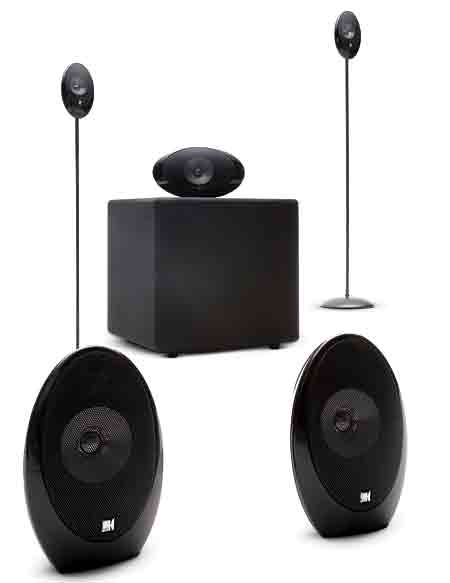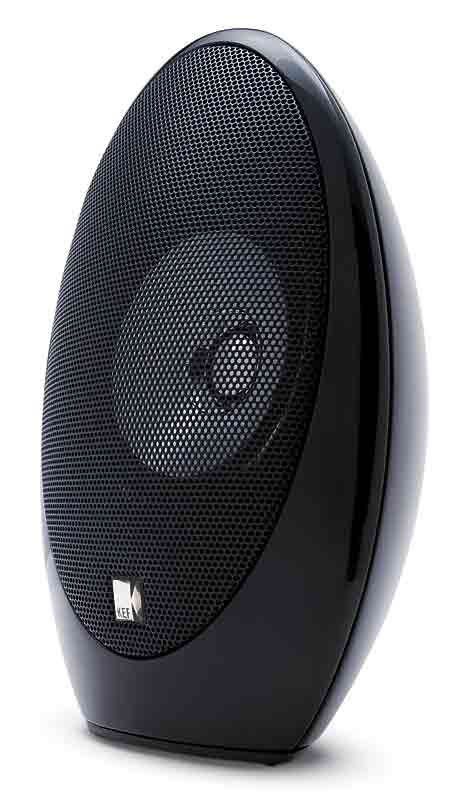KEF KHT1005.2 Speaker System
Sunny Side Up
Folks buying compact satellite/subwoofer sets to complement their flat-panel HDTVs? That’s old news. Now some manufacturers are offering even more compact speakers to complement the new breed of flat panels. The focus is now on flat panels that reduce the frame surrounding the screen to an absolute minimum, so that the picture seems to float against the wall.

Did you just buy one of those thin-bezel sets? One of the Toshiba Regzas, perhaps? Maybe you’d like an oh-so-small satellite/subwoofer set with a finish that matches the Regza’s skinny black bezel. I suspect that’s what the folks at KEF had in mind when they designed the KHT1005.2, a.k.a. the 1000 Series.
This is not the first KEF sat/sub set that features egg-shaped speakers. I reviewed the similar-looking, larger 3000 Series in 2006. And KEF also has a 2000 Series. So once again, I have omelets on the brain. And fried eggs sunny side up with runny yolks. And scrambled eggs with American bacon. And poached eggs with fabulous British bacon—have I mentioned that KEF is a British brand?
The Yolk Inside the Egg
The HTS1001.2 satellite and HTC1001.2 center-channel speaker are identical except for their vertical and horizontal enclosures. The satellite is 6.5 inches tall, but it looks smaller. This might be because of its curved shape and minimal depth. Its cast-aluminum eggshell is two-thirds the size of the satellite in the last egg-shaped KEF we reviewed. If other members of your household are opposed to a 5.1-channel speaker system in a carefully designed room, these attractive yet modest speakers just might meet their requirements for taste and discretion.
Seen from the front, the satellite is oval shaped and tilts very slightly backward from its small base. This suggests a location below the screen. Beneath the undetachable black metal grille is KEF’s Uni-Q “coincident” driver array—the yolk, if you will. Uni-Q is the company’s proprietary name for what is generically known as a coaxial array, with the 0.6-inch aluminum-dome tweeter set into the center of the 3-inch cone midwoofer.

This feature offers several benefits. One is that it saves space. This allows the speaker to be almost miraculously small. Secondly, it provides an audible benefit. The two drivers approximate a point source, so that their respective outputs seem to come from the same place. This reduces phase problems and gives these coaxial speakers a laser-like focus and a more consistent off-axis response. The downside is a modest coloration when the tweeter’s output bounces off the inside of the woofer’s cone. But KEF has had enough practice with this kind of design to minimize the effect.
KEF designed these speakers to be small enough to rely exclusively on their Uni-Q array—with no additional woofers to spoil the symmetry. This adds yet another benefit. The speakers have a total absence of lobing, the effect that can occur in speakers with physically separate drivers. Two-way horizontal center speakers with a woofer-tweeter-woofer configuration most annoyingly demonstrate this. True, the center in this system is horizontal (6.5 inches wide instead of 6.5 inches tall). But otherwise, it’s identical to the other satellites in size, shape, and most crucially, driver position. With just the coaxial array, KEF minimized the off-axis summation and cancellation effects that cause lobing. The speakers feature a consistent dispersion pattern that’s identical across all three front channels. If the coaxial array accomplished nothing but this, it would still be incredibly worthwhile.
On the speaker’s glossy rounded back, KEF provides terminals that look like binding posts but operate like wire clips. If you press down, it will reveal a hole in the side where you can push in your bare wire tips. The holes are too small for standard banana plugs, and there’s no provision for spade lugs either. Like many sats, this one is designed for bare wire or maybe pin connectors. The connection is secure. I frequently picked up one of the sats to examine it. I twisted it around and admired it from various angles. But the terminals never relinquished their iron grip on the tips of my Monster THX ribbon cables.
Although there’s no threaded insert for wall mounting, KEF supplies a right-angled wall bracket that fits around the speaker’s bottom and back. I didn’t attempt a wall mount, but the speaker’s coaxial design and slightly bright tonal balance would make wall mounting an especially viable option. Wall proximity tends to make many speakers sound murky by reinforcing the midbass output. However, that change won’t necessarily affect these speakers negatively. Another option is the optional stands—slim metal rods. Audio nuts generally like to get their speakers out from the wall to minimize wall interaction and obtain clearer sound.
In this 1000 Series system and the 2000 Series, KEF broke from the 3000 Series’ oval sub in favor of a more conventional box shape. The KUBE-1 has two side-firing 8-inch drivers in a sealed box sitting on 0.5-inch rubber feet. Rated power is 150 watts. The sub is glossy black on the top, but fabric surrounds it on all sides, including the back, where there’s a metal plate for the minimal control panel. The packaging includes a sheet that warns you not to stretch the cloth by grasping the fabric surfaces. KEF provides the usual controls for volume, crossover, and phase. The only jacks are stereo line-level inputs—it doesn’t contain any outputs or speaker-level jacks.
- Log in or register to post comments




































































